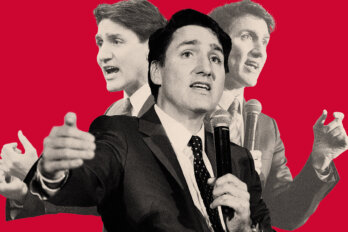Justin Trudeau’s Liberals may have won the 2015 election in part because of their willingness to run deficits, but they surely never imagined the one they’re currently carrying. According to the most recent numbers, the deficit for the 2020/21 fiscal year could reach $343 billion—a figure nearly seven times as large as the deficit Canada racked up during the 2008/09 financial crisis. We are likely heading toward the largest deficit since the Second World War.
The money is being spent on everything from direct supports for Canadians, like the Canada Emergency Response Benefit (CERB) and Canada Emergency Wage Supplement (CEWS), to transfers for provinces and municipalities, which help them manage the sudden shortfalls in their own revenues. And, while it’s all in the service of preventing Canada’s economy from flatlining from the devastating fallout of a global pandemic, it has some people wondering if the treatment is worse than the disease. The economic snapshot released by the federal government in July described the unprecedented deficit as the “challenge of our lifetime” while, in an August tweet, Conservative senator Leo Housakos accused the prime minister of leading “the greatest country in the world into bankruptcy.”
But what if we didn’t have to raise taxes or cut spending to reduce our COVID-19 debt? What if the Bank of Canada could pay it all down simply by printing more money? That’s the basic tenet behind modern monetary theory (MMT), an economic idea that has found new popularity in recent months. MMT proposes that countries that issue their own currency, like Canada and the United States, can’t go broke the way a household or business can and therefore don’t need to worry quite as much about running up debt.
Leading this resurgence in MMT is Stephanie Kelton, a former economic adviser to Bernie Sanders and the author of The Deficit Myth: Modern Monetary Theory and the Birth of the People’s Economy. In the book, she argues that the prevailing narrative about government finances is informed by a false sense of scarcity when it comes to budgeting, and that abandoning this belief could open up a range of possibilities for progressive legislation aimed at saving the planet, improving living standards and education, and creating sustainable infrastructure—programs for which governments always claim to not have enough money. “What if I showed you that the deficit bogeyman isn’t real?” Kelton writes. “What if I could convince you that we can have an economy that puts people and planet first? That finding the money to do this is not the problem?”
This is heresy among more conventional economists, never mind the politicians and pundits who pride themselves on fiscal discipline. After all, we’ve been told for decades that government deficits and debt lead to a weaker currency, more inflation, and ultimately financial ruin. We’ve also been told that there are basically two policy responses to debt and deficit: tax increases or spending cuts. But, after watching governments and central banks throw trillions of dollars at the COVID-19-driven economic crisis only to have inflation disappear and interest rates drop to zero, that consensus may be cracking. “There is a big rethink happening on this, even in the mainstream community,” says Marc-Andre Pigeon, an assistant professor at the University of Saskatchewan’s Johnson Shoyama Graduate School of Public Policy and a long-standing MMT proponent.
As Pigeon argued in a policy brief, this rethink could fundamentally alter the way we understand the defining challenges of a postpandemic world. Rather than worrying about balancing the budget or paying down debt, governments could be empowered to invest in ways that address the social and environmental deficits we’ve been racking up for decades. If we keep that in mind, Pigeon writes, we might find ourselves “discarding the fiscal scolds just as Copernicus discounted those who insisted on the increasingly convoluted Ptolemaic model that put the earth at its centre.”
Modern monetary theory traces its origins to the early twentieth century, when a German economist named Georg Friedrich Knapp theorized that the intrinsic value of a currency wasn’t a function of its relationship to a commodity, like gold, but came from people’s faith in the government that backstopped that currency. In other words, economies could print as much money as they needed; they weren’t constrained by the size of their gold reserves. Knapp’s theory was augmented in the 1940s by Russian-born economist Abba Lerner, who suggested that, because deficits could coexist easily with low inflation—and because printing money to pay for the former didn’t have to raise the latter—government spending could be as ambitious as it needed to be. But Lerner’s ideas, already unconventional at the time, became radioactive by the 1970s, when a nasty bout of stagflation (that is, the combination of rising inflation and rising unemployment) hit the Western world.
MMT, however, wasn’t dead—just resting. For decades, the theory was discussed and debated only within the confines of academia. That is, until Democratic representative Alexandria Ocasio-Cortez told Business Insider, in January 2019, that MMT “absolutely” needed to be “a larger part of our conversation.” Suddenly, it seemed like everyone with even a passing interest in economic theory was talking about the idea, either warming to its possibilities or recoiling from its implications. As the Economist noted last July, “A profound shift is now taking place in economics as a result, of the sort that happens only once in a generation.”
Not surprisingly, MMT has its share of detractors. “The idea that deficits don’t matter for countries that can borrow in their own currency I think is just wrong,” said Federal Reserve chairman Jay Powell. In 2019, Berkshire Hathaway CEO Warren Buffett suggested that, if a government relied on its central bank to buy its debt, this could reduce demand for its currency, undermine the value of that currency, and eventually risk “spiralling” inflation, which when left unchecked can burn through an economy like wildfire. His long-time business partner Charlie Munger went even further, telling a CNBC reporter, “I am so afraid of a democracy getting the idea that you can just print money to solve all problems. Eventually, I know, that will fail. ‘You don’t have to raise taxes, you just print.’ In the end, if you end up printing too much, you end up like Venezuela.”
Munger was referring to the way inflation had ravaged the once-strong Venezuelan economy over the last decade, driving millions into poverty and starvation. MMTers like Pigeon and Stephanie Kelton readily acknowledge both the risks of inflation and the need to contain it. But the notion that a stable democracy like Canada could quickly devolve into a failed kleptocracy like Venezuela ignores that the Canadian government actually has a number of preemptive tools at its disposal, from tax increases to more stringent regulations on lending and finance, that would control the amount of money flowing through the economy and avoid sparking episodes of runaway inflation.
There’s also the fact that the conventional understanding of the relationship between deficits and inflation can’t explain Japan, where enormously high debt-to-GDP levels (it surpassed 200 percent in 2019; in Canada, debt was approximately 31 percent of GDP that year) have coexisted with a strong currency and ultralow interest rates for decades. According to some traditional economists, this shouldn’t be possible—those deficits and that debt should have pushed down demand for the yen, which in turn would have made Japan’s imports more expensive, thus fuelling inflation and triggering a jump in the interest rate to snuff it out. But inflation in Japan has remained relentlessly and remarkably muted, and its currency trades at the same valuations as it did back in the 1990s.
We have our own examples of debt and deficits not leading to economic ruin here in North America. In 2008/09, central banks pumped trillions of dollars into global credit markets in an effort to avert total economic collapse. Despite dire warnings about the imminent threat of inflation, it never actually materialized. Interest rates remained low, the US dollar remained strong, and inflation remained conspicuously muted. Nevertheless, those warnings have returned as governments backed up their proverbial trucks in an effort to prevent another economic collapse in the face of COVID-19, and they will almost certainly continue to shape the conversation around what we do after the virus passes.
But MMT offers an intriguing alternative to the fiscal austerity that Canada turned to in the 1990s and 2000s in order to start cutting into the national debt. And, according to Pigeon, this country is well-positioned to serve as an incubator for these new ideas. Not simply because we issue our own currency but because the Bank of Canada enjoys a rare level of freedom. “I think Canada’s probably been a better case study for the MMT propositions than the United States,” he says, “in the sense that, operationally, there’s very few restrictions around what the Bank of Canada can do versus what the Federal Reserve can do.”
This isn’t just a matter for fiscal-policy wonks. Embracing MMT and investing in ways to address our social and environmental deficits could help policy makers close the gap between rich and poor, heal some of the fissures in society, and avoid the kind of populist flashpoints that Pigeon believes has led to situations like Brexit and the Trump presidency. As working people have fallen ever further behind those with capital and wealth, they’ve increasingly turned to political leaders who promise easy solutions. In that light, inflation might be the least of Canada’s problems. “There are worse outcomes,” Pigeon says, “and I think we’ve lived a lot of that in the last thirty or forty years.”
Indeed, as a trio of pro-MMT economists argued in a 2019 Financial Times piece, “Commenters are not wrong that some of these proposals and tools will be controversial. What is ignored by this criticism is the fact that our current approach of managing inflation on the backs of a very indebted and underemployed public is also controversial.” Time will tell whether we can get past the language of belt-tightening and boot-strapping to have a more creative conversation about the role and purpose of government spending. But one thing is already clear: governments can spend far more during an emergency than we ever thought possible. The real question is how we’ll define what qualifies as an emergency—and how willing we’ll be to respond to it.





